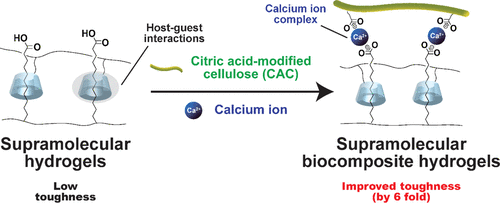当前位置:
X-MOL 学术
›
Biomacromolecules
›
论文详情
Our official English website, www.x-mol.net, welcomes your feedback! (Note: you will need to create a separate account there.)
Supramolecular Biocomposite Hydrogels Formed by Cellulose and Host-Guest Polymers Assisted by Calcium Ion Complexes.
Biomacromolecules ( IF 6.2 ) Pub Date : 2020-08-18 , DOI: 10.1021/acs.biomac.0c01095 Hinako Tsuchiya 1 , Garry Sinawang 1, 2 , Taka-Aki Asoh 3 , Motofumi Osaki 1, 2 , Yuka Ikemoto 4 , Yuji Higuchi 5 , Hiroyasu Yamaguchi 1, 2 , Akira Harada 2, 6 , Hiroshi Uyama 3 , Yoshinori Takashima 1, 2, 7
Biomacromolecules ( IF 6.2 ) Pub Date : 2020-08-18 , DOI: 10.1021/acs.biomac.0c01095 Hinako Tsuchiya 1 , Garry Sinawang 1, 2 , Taka-Aki Asoh 3 , Motofumi Osaki 1, 2 , Yuka Ikemoto 4 , Yuji Higuchi 5 , Hiroyasu Yamaguchi 1, 2 , Akira Harada 2, 6 , Hiroshi Uyama 3 , Yoshinori Takashima 1, 2, 7
Affiliation

|
Hydrogels are biocompatible polymer networks; however, they have the disadvantage of having poor mechanical properties. Herein, the mechanical properties of host–guest hydrogels were increased by adding a filler and incorporating other noncovalent interactions. Cellulose was added as a filler to the hydrogels to afford a composite. Citric acid-modified cellulose (CAC) with many carboxyl groups was used instead of conventional cellulose. The preparation began with mixing an acrylamide-based αCD host polymer (p-αCD) and a dodecanoic acid guest polymer (p-AADA) to form supramolecular hydrogels (p-αCD/p-AADA). However, when CAC was directly added to p-αCD/p-AADA to form biocomposite hydrogels (p-αCD/p-AADA/CAC), it showed weaker mechanical properties than p-αCD/p-AADA itself. This was caused by the strong intramolecular hydrogen bonding (H-bonding) within the CAC, which prevented the CAC reinforcing p-αCD/p-AADA in p-αCD/p-AADA/CAC. Then, calcium chloride solution (CaCl2) was used to form calcium ion (Ca2+) complexes between the CAC and p-αCD/p-AADA. This approach successfully created supramolecular biocomposite hydrogels assisted by Ca2+ complexes (p-αCD/p-AADA/CAC/Ca2+) with improved mechanical properties relative to p-αCD/p-AADA hydrogels; the toughness was increased 6-fold, from 1 to 6 MJ/m3. The mechanical properties were improved because of the disruption of the intramolecular H-bonding within the CAC by Ca2+ and subsequent complex formation between the carboxyl groups of CAC and p-AADA. This mechanism is a new approach for improving the mechanical properties of hydrogels that can be broadly applied as biomaterials.
中文翻译:

由纤维素和钙离子配合物辅助的客体聚合物形成的超分子生物复合水凝胶。
水凝胶是生物相容性聚合物网络;但是,它们具有机械性能差的缺点。在此,通过添加填料并结合其他非共价相互作用,可以提高宿主-客体水凝胶的机械性能。将纤维素作为填料添加到水凝胶中以提供复合材料。使用具有许多羧基的柠檬酸改性的纤维素(CAC)代替了常规纤维素。制备开始时将基于丙烯酰胺的αCD主体聚合物(p-αCD)和十二烷酸客体聚合物(p-AADA)混合以形成超分子水凝胶(p-αCD/ p-AADA)。但是,当将CAC直接添加到p-αCD/ p-AADA形成生物复合水凝胶(p-αCD/ p-AADA / CAC)时,其力学性能比p-αCD/ p-AADA本身弱。这是由于CAC中强分子内氢键(H键)引起的,从而阻止了CAC在p-αCD/ p-AADA / CAC中增强p-αCD/ p-AADA。然后,氯化钙溶液(CaCl2)用于在CAC和p-αCD/ p-AADA之间形成钙离子(Ca 2+)络合物。这种方法成功地创建了由Ca 2+配合物(p-αCD/ p-AADA / CAC / Ca 2+)辅助的超分子生物复合水凝胶,相对于p-αCD/ p-AADA水凝胶,其机械性能得到改善;韧性提高了6倍,从1增至6 MJ / m 3。由于Ca 2+破坏了CAC内的分子内H键,并随后在CAC和p-AADA的羧基之间形成了络合物,从而改善了机械性能。这种机制是一种改善水凝胶机械性能的新方法,可以广泛用作生物材料。
更新日期:2020-09-14
中文翻译:

由纤维素和钙离子配合物辅助的客体聚合物形成的超分子生物复合水凝胶。
水凝胶是生物相容性聚合物网络;但是,它们具有机械性能差的缺点。在此,通过添加填料并结合其他非共价相互作用,可以提高宿主-客体水凝胶的机械性能。将纤维素作为填料添加到水凝胶中以提供复合材料。使用具有许多羧基的柠檬酸改性的纤维素(CAC)代替了常规纤维素。制备开始时将基于丙烯酰胺的αCD主体聚合物(p-αCD)和十二烷酸客体聚合物(p-AADA)混合以形成超分子水凝胶(p-αCD/ p-AADA)。但是,当将CAC直接添加到p-αCD/ p-AADA形成生物复合水凝胶(p-αCD/ p-AADA / CAC)时,其力学性能比p-αCD/ p-AADA本身弱。这是由于CAC中强分子内氢键(H键)引起的,从而阻止了CAC在p-αCD/ p-AADA / CAC中增强p-αCD/ p-AADA。然后,氯化钙溶液(CaCl2)用于在CAC和p-αCD/ p-AADA之间形成钙离子(Ca 2+)络合物。这种方法成功地创建了由Ca 2+配合物(p-αCD/ p-AADA / CAC / Ca 2+)辅助的超分子生物复合水凝胶,相对于p-αCD/ p-AADA水凝胶,其机械性能得到改善;韧性提高了6倍,从1增至6 MJ / m 3。由于Ca 2+破坏了CAC内的分子内H键,并随后在CAC和p-AADA的羧基之间形成了络合物,从而改善了机械性能。这种机制是一种改善水凝胶机械性能的新方法,可以广泛用作生物材料。


























 京公网安备 11010802027423号
京公网安备 11010802027423号